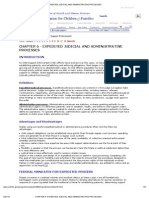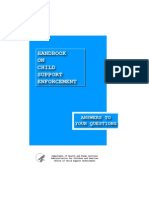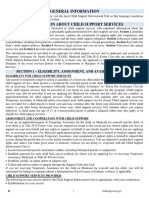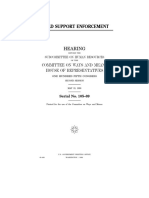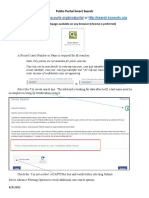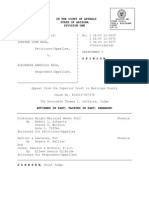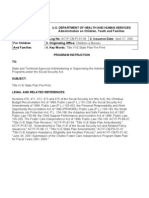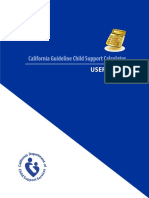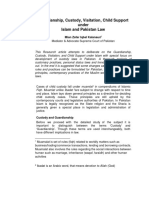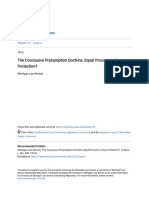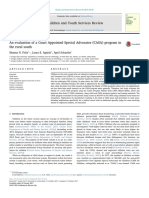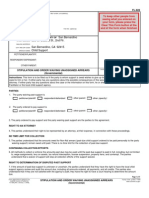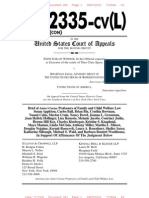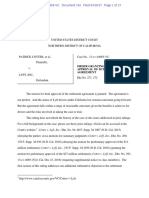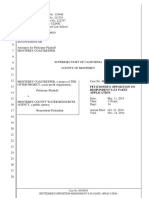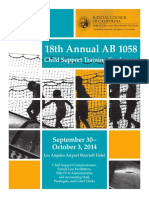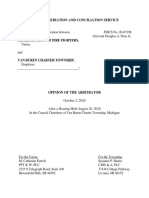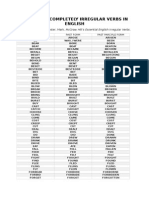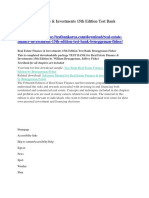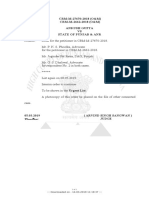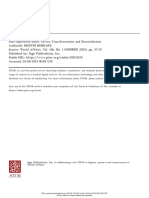The Child Support Program in California:
Current Challenges, Future Objectives 1
"The timely receipt of child support is critical for millions of
American families and children . . . promoting family self-sufficiency
and child well-being."
– U.S. Dep't of Health & Human Services, Administration for Children
and Families
I. The Importance of Winning the Child Support Enforcement Challenge
California, like all the states, has struggled mightily for years to improve its performance
in collecting child support for needy families and children. The simple fact is that child
support – financial support provided by one parent, generally the noncustodial parent, to
the child – is critical to the financial security of millions of children across the nation and
throughout California. Half of all children who live in poverty, live with one parent, with
the other parent living elsewhere. 2 For low-income families who receive child support,
child support accounts for 40 percent of their income. 3 Child support is also a substantial
source of income for families leaving welfare. Over 40 percent of children in post-
welfare families receive child support; and, for those that do, child support accounts for
30 percent of their income. 4
The child support program also has other benefits. Effective child support enforcement
promotes marriage and reduces births to unwed parents. In addition, parents who pay
child support are more likely to be involved with their children. 5 Finally, successful child
support enforcement not only recoups public assistance expenditures, but also reduces the
need for public assistance in the first place. 6
II. How California's Program Is Structured
Pre-1999: The origins of California's child support program go back to 1872 when
California first adopted the Penal Code, which made failure to pay child support a
misdemeanor, later increased to a felony. 7 From the 1950's until the early 1970's,
California enacted a series of laws governing child support enforcement, and most
counties established Family Support Divisions within their district attorneys' offices to
enforce those support obligations.
1
This paper was prepared by Leora Gershenzon, Counsel, Assembly Judiciary Committee, March 2005
2
Sorensen E., Child Support Gains Some Ground, Snapshots of American Families, Urban Institute (2003).
3
U.S. Census Bureau, Custodial Mothers and Fathers and Their Child Support: 2001, P60-225 (2003).
4
Sorensen E., Child Support Gains Some Ground, supra Note 2 Sorensen, E and C. Zibman, Child
Support Offers Some Protection Against Poverty, Series B, No. B-10, Urban Institute (2000).
5
Seltzer, J., et al, Will Child Support Enforcement Increase Father-Child Contact and Paternal Conflict
After Separation? in Garfinkel, et al, FATHERS UNDER FIRE (1998).
6
Cost avoidance is $2.6 billion nationally. Wheaton, L., Child Support Cost Avoidance in 1999, Final
Report, Office of Child Support Enforcement (2003).
7
Penal Code 270.
1
�When the federal child support program began in 1975, California established the
Department of Social Services (DSS) as the single state agency responsible for
administration of the state's child support program. DSS, however, did not operate the
program alone, but contracted out the day-to-day operations of the program to the 58
county district attorneys' office.
Throughout the 1990's California's child support program found itself under attack by
parents, advocates and the media for its lackluster performance and automation failures
(see below). In 1998, the Los Angeles Times ran an in-depth series documenting the
failures of the child support program in Los Angeles County and across the state. 8 On
January 26, 1999, the Assembly and Senate Judiciary Committees and the Assembly
Human Services and Senate Heath and Human Services Committees held a joint hearing
on the program entitled Reforming California's Child Support System: A Consensus for
Action.
The Dramatic 1999 Legislative Reforms: Following the landmark two house hearings
reviewing the continuing inadequacies of the state's child support enforcement program,
an unusual consensus for action arose, and in 1999 the Legislature spearheaded major
structural reforms in the program by (1) transferring state responsibility from DSS to the
newly created Department of Child Support Services (DCSS); (2) transferring local
responsibility for the program from the district attorneys to local child support agencies
(LCSAs) which, except for hiring decisions, were put under the control of DCSS; and (3)
creating a complaint resolution and fair hearing process for resolving child support
complaints. 9
Pursuant to the legislation, DCSS was required to develop uniform forms, policies and
programs, and performance standards. If LCSAs failed to meet required performance
standards, DCSS was to assist in program operations and management. In contrast to its
previous funding structure, the reformed program was now funded entirely through
federal and state funds.
III. History of the Federal Child Support Program
A. The Federal Program
Enacted in 1975, Title IV-D of the Social Security Act requires all states with a welfare
program to operate a child support program which establishes and enforces child support
obligations. 10 Title IV-D requires every state to establish a single organizational unit
responsible for the state's child support enforcement program. The child support
requirements have been expanded and strengthened considerably since the program's
creation. Amendments in 1988 strengthened the program by requiring wage withholding
for current support as well as past-due support. The 1988 act also required all states to
8
Greg Krikorian & Nicholas Riccardi, Failure to Provide: Los Angeles County's Child Support Crises,
LOS ANGELES TIMES A1 (October 11-13, 1998).
9
SB 542 (Burton/Schiff), Chapter 480, Statutes of 1999; AB 196 (Kuehl), Chapter 478, Statutes of 1999;
AB 472 (Aroner), Chapter 803, Statues of 1999.
10
P.L. 93-647 (H.R. 17045), 42 U.S.C. §651 et seq.
2
�implement statewide automated child support systems for all cases in the states' IV-D
caseload by October 1, 1995, later extended to October 1, 1997. 11 Significant
amendments in 1996 again expanded program requirements and required all states to
operate a State Disbursement Unit (SDU) as part of their automated system. 12
The Child Support Performance and Incentive Act of 1998 (CSPIA) established new
federal performance measures and an incentive and penalty structure to fund and
motivate states to improve their child support performance efforts. 13 Under CSPIA,
states receive federal incentives based on performance on five federal performance
measures: (1) paternities established; (2) support orders established; (3) current support
collected; (4) arrears collected; and (5) cost-effectiveness. In order to obtain incentive
payments, and to avoid penalties, the performance data must be deemed by the federal
government to be complete and reliable.
The incentive pool for the states is capped. Thus, California's incentive is based not only
on its performance on the five measures and its total support collections, but also on the
performance of the other states. The federal incentive pool for federal fiscal year 2005 is
$446 million, increasing to $458 million in 2006 and $471 million in 2007. In addition,
the incentive dollars are matched $2 for each $1 with federal match dollars.
Recognizing that not all states were able to complete their child support automation
systems by the deadline, CSPIA also provided an alternative penalty scheme. When
many states failed to meet the 1997 automation deadline, CSPIA established an
alternative penalty scheme whereby penalty for failure to complete the automation
system now results in a loss of federal administrative funding of the child support
program, beginning at 4 percent the first year and rising to 30 percent by the fifth and
subsequent years until the automation system is certified as complete. The penalty is
reduced by 90% in any year that a state successfully completes its automation system.
B. The Federal Computer Automation Requirements
California's first attempt to produce a statewide automated child support system, called
the Statewide Automated Child Support System (SACSS), was developed by Lockheed
Martin Information Management Systems. Major systemic problems were discovered
very early in the process, but development continued. By 1997, after well over $100
million had been expended and the federal deadline for completion of the automation
system had passed, it became apparent that SACSS would never perform adequately, and
California terminated the contract. 14
California's next attempt to develop a single statewide system, spearheaded by local
district attorneys, was a consortia approach. Under that approach, four county systems
11
P.L. 100-485 (HR 1720). The automation deadline was extended pursuant to P.L. 104-35 (HR 2288)
12
P.L. 104-193 (H.R. 3724).
13
P.L. 105-200 (HR 3130), as amended by P.L. 105-34 (HR 2015).
14
For more information on SACSS's failures, see California State Auditor, Health and Welfare Agency:
Lockheed Martin Information Management Systems Failed to Deliver and the State Poorly Managed the
Statewide Automated Child Support System (March 1998); California State Assembly Committee on
Information Technology, The $260 Million Dollar Question: Will the Statewide Automated Child Support
System (SACSS) Ever Really Work? An Addendum (November 1977).
3
�were to be linked together to form a statewide system. 15 That proposal, which required
substantially upgrading existing systems and then developing an overarching computer
architecture to link the systems together, was ultimately rejected by the federal
government.
California's latest attempt began in 1999 with AB 150 (Aroner), Chapter 479 of the
Statutes of 1999. That legislation established a partnership between DCSS and the
Franchise Tax Board to procure, develop, implement and maintain a statewide automated
child support system. Development of the automation system, known as the California
Child Support Automation System (CCSAS), began in earnest in 2000. The system has
two components: the Child Support Enforcement (CSE) system and the SDU. After
competitive procurements, a team of vendors led by IBM was awarded the CSE contract
in July 2003, and Bank of America was awarded the SDU services contract in December
2004. The IBM contract is for $801 million, the Bank of America seven-year contract is
for $186 million, and the total ten-year project costs are projected to be $1.3 billion.
In an attempt to minimize federal penalties, CCSAS has been designed in two phases.
The first phase, Version One, is an alternative system configuration (linking two existing
county systems with a statewide database) allowing for early certification and an end to
penalties. The second phase, Version Two, is designed to implement a state-of-the-art
single statewide system which should significantly improve program performance.
IV. Five Years Since the 1999 Legislative Reorganization of the Program: Just
How Far Have We Come, and What Are the Key Remaining Challenges?
A. California Program Performance: A Mixed Bag
In an effort to improve performance, DCSS, in collaboration with local agencies and other child
support stakeholders, developed a strategic plan that set forth annual statewide performance
goals for the five federal measures and additional state measures. 16 The statewide measures
were then translated down annually to local performance expectations for each of the local child
support agencies. Finally, DCSS developed a Quality Assurance and Performance
Improvement Plan, to continually assess results and refine program operations to achieve
performance expectations.
The results of California's child support performance efforts since 2000 are for the most
part positive. California has improved performance on three of the five federal measures
(paternities established, orders established and current support collections) held relatively
flat on one measure (arrears collections) and lost ground on one measure (cost-
effectiveness). Tables 1 and 2 below set forth California's performance on the federal
measures since 2000.
15
See AB 2779 (Aroner), Chapter 329 of the Statutes of 1998.
16
DCSS, California Child Support Services Program: Strategic Plan 2002 – 2005.
4
� TABLE 1. California's Performance on the Federal Performance Measures
100%
90%
80%
70%
60%
2000
2001
50% 2002
2003
2004
40%
30%
20%
10%
0%
Paternities Established Support Orders Established Current Support Arrears Collections
Source: DCSS.
California's Performance on the Cost-Effectiveness Measure
$3.00
$2.50
$2.00
$1.50
$1.00
$0.50
$0.00
2000 2001 2002 2003 2004
Source: DCSS.
Despite the improvements that California has made on the measures, the state still lags
behind the nation on several key measures. Of the five measures, California performs
above the national average on two measures (paternities and support orders established),
5
�below on one (arrears collections) and significantly below on two (current support
collections and cost-effectiveness). California's rank on the performance measures in
federal fiscal year 2003 (2004 data are not yet available nationally) compared with the
other states and territories is set forth in the Table 3:
TABLE 3: California's Rank on the Federal Child Support Measures
Performance Measure Rank
Paternities Established 11/26 17
Orders Established 24/54
Current Support Collections 51/54
Arrears Collections 41/54
Cost-Effectiveness 50/54
Source: Federal Office of Child Support Enforcement, Child Support Enforcement FY 2003 Preliminary
Data Report.
The incentive payments that a state receives from the federal government are based not
only on the state's performance on the five federal measures, but also on its total
collections. The federal incentive formula is based on a state's performance on the
measures multiplied by its total collections, with a greater weight being applied to
collections made on behalf of current and former assistance families. As Table 4 shows,
overall collections have been steadily rising, although the percentage increase has been
leveling out recently.
TABLE 4. California's Child Support Collections
$2,500,000,000
$2,000,000,000
$1,500,000,000
$1,000,000,000
$500,000,000
$0
1999-2000 2000-2001 2001-2002 2002-2003 2003-2004 2004-2005
Source: DCSS.
When California's actual performance is compared with the goals set forth in its Strategic Plan,
California's performance has been mixed, with some goals achieved while others goals, notably
17
States have an option to use one of two paternity establishment measures: one using just the IV-D
caseload (set forth in Table 3) or one using a statewide paternity measurement. California ranks 3 out of 31
states under the latter measurement.
6
�in the area of current support and arrears collections, have not been achieved. DCSS has
recently reduced its performance goals for these two measures even further by permitting local
agencies to performance at either their 2004 goal or just 0.5 or 1 percentage point above that
goal. 18 This reduction in expectations could not only reduce support collected for children, but
could also reduce California's incentive payments, particularly because no other state appears to
be reducing its performance expectations.
B. Automation Failures and Penalties
As discussed above, California is now developing the CCSAS project in two phases:
Version One, which seeks to link two existing system and, under an alternative system
configuration, end the federal penalties, and Version Two, which will implement a true
statewide system. Version One was originally scheduled to be completed by February
2006, but system competition has been moved up to September 2005. Version Two is
anticipated to be completed by September 2008. The SDU is scheduled to begin
operations in September 2005, although the roll out to all the local child support agencies
is not expected to be completed until the following year.
Table 5 sets forth the automation penalties, which are anticipated to reach a cumulative
total of $1.2 billion through 2006. Note, the penalties will be reduced by 90 percent in
the federal fiscal year the state successfully implements the system.
TABLE 5. California's Automation Penalties
Federal State Fiscal Penalty Penalty Amount Cumulative Penalty
Fiscal Year Year Rate (in the millions) (in the millions)
1998 1997-98 4% $12 $12
1999 1998-99 8% $27 $39
2000 1999-00 16% $65 $104
2001 2000-01 25% $111 $215
2002 2001-02 30% $157 $372
2003 2002-03 30% $190 $562
2004 2003-04 30% $192 $754
2005 2004-05 30% $218 $972
2006 2005-06 30% $223 $1,195
Source: DCSS.
California had sought to limit the federal penalties through legislation introduced by
Congressman Matsui in 2002. 19 While supported by numerous local, state and national
organizations, as well as over half of California's congressional delegation, that
legislation did not move in Congress. California then sought to pay the penalties
annually, rather than quarterly. The Bush Administration agreed to that request for 2005,
18
Child Support Services (CSS) Letter No. 04-23 (October 22, 2004).
19
H.R. 4857 (2002).
7
�but has denied a similar request for the 2006 federal fiscal year. 20 As a result, assuming
California is unable to seek certification of its system by the end of federal fiscal year
2005, California will be required to pay both the 2005 and three-fourths of the 2006
federal penalty in the 2005-06 state fiscal year.
California had considered completing Version One and the SDU by September 30, 2005
in order to seek penalty relief during the 2005 federal fiscal year. However, in October
2004, the federal Department of Health and Human Services informed California that the
child support system would not be considered complete and the state not subject to
penalty relief until the SDU was fully operational, receiving "all IV-D payments and
mandated non-IV-D payments," which is unlikely to occur by September 2005. 21 It is not
at all certain that other states were held to this strict completion interpretation.
As a result, California is expected to pay over $1 billion in penalties to the federal
government, unless the schedule is somehow accelerated, the federal Health and Human
Services Department relaxes its requirement that the SDU is operating in all cases on the
date the state seeks certification or Congress authorizes some form of penalty relief.
V. Issues for Consideration: Opportunities for Improvement
In reviewing the history and current performance of California's child support program,
there are several areas that may provide opportunities to improve the effectiveness and
efficiency of California's program. These areas may prove ripe for further investigation
and possible new legislative action.
1. Performance expectations: Given the importance of child support for children
and the federal incentive and penalty scheme, should California develop
statewide, aggressive performance expectations to further drive program
improvements? Is it appropriate for the Legislature to establish and closely
monitor statewide performance expectations?
2. Sufficient state control: Does the state DCSS have sufficient control over the
local child support agencies to ensure necessary improvements in program
operations can be implemented statewide? Is there more that can be done to
ensure performance goals are achieved? Does DCSS need additional tools to
enhance performance at the local level? Do local agencies need additional tools?
3. Automation implementation and penalty elimination: Is development of the
California Child Support Automation System on track? Is there sufficient state
oversight of the project? Is the federal government treating California the same as
other states as California prepares to implement the statewide child support
automated system? Is it possible for California to complete Version One and
terminate federal penalties by the end of 2005? If so, what efforts are necessary?
If not, are there other steps that California can take, whether through Congress or
the Bush Administration, to reduce penalties?
20
Letter from Deputy Assistant Secretary Curtis Coy to Deputy Director Olivia Cortez (February 4, 2005).
21
Letter from Assistant Secretary Wade Horn to Secretary Kim Belshé (October 19, 2004).
